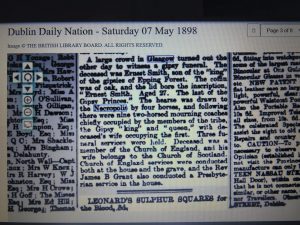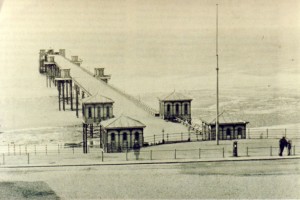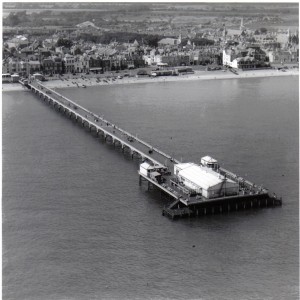James Hunter Lawrie
Tuesday, July 22nd, 2014Alan Drummond Law
Tuesday, July 22nd, 2014William Laird
Tuesday, July 22nd, 2014David Myles Laidlaw
Tuesday, July 22nd, 2014Alexander Porter Leitch
Friday, March 11th, 2011The information for this profile of her father was supplied by Dorothy Mackay-Collins, St. Helena, California.
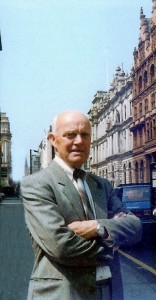
Alexander Porter Leitch was born in Glasgow April 5, 1909 the fifth child of Catherine Stewart Cruickshank and Charles Leitch both of the City of Glasgow. Together they had six sons and lived in a tenement flat on York Street.
When at school around age 10 his teacher, who was watching him draw, said: “Keep that up Leitch and you’ll make your money with that pencil. some day”. Alec left school at 14 and worked delivering various legal papers for some business in the City. In 1924, at the age of 15, he began his apprenticeship as a joiner for the Harland and Wolfe Shipyard in Linthouse, Govan. In 1931, during the Depression. along with many others, Alec was laid off. He walked the streets trying to find another job, discovered a contractor who was building houses and signed on as a roofer.
When the job was finished, he went to Douglas, Isle of Man for a fortnight’s holiday and met Rubina Campbell Giffin. Before the end of the holiday he told her he was serious and wanted to marry her, adding that it would be 5 years before they could afford to marry.
In 1935 work at the shipyard began again and Alec returned to Harland and Wolfe. He also enrolled in Night School and began a seven year course in drafting. Later that year he went on holiday to Bangor and met Ruby again. They agreed to save up for marriage and planned it for April, 5, 1936. They were married in the Macgregor Memorial Church in Whiteinch. In 1937 a daughter, Dorothy Leitch, was born in the flat they rented in 25 Hutton Drive, Linthouse.
The Second World War broke out in 1939 and Alec remained at the shipyard working days and nights to assist in the repair of ships brought in and turned around for immediate sea duty. A son, William Cruickshank Leitch, was born in the Linthouse flat in 1943. The night William was born there was an air raid. Ruby’s mother was present at the birth and when the air raid started soon after there was a flurry of activity. Alec rounded up some men with a make-shift stretcher and the men carried Ruby to the nearest shelter. As it turned out Ruby’s mother and the baby were in a different shelter. Not until the all-clear and a return home did they discover that Dorothy was missing but thankfully she was rescued by the Home Guard and safely returned.
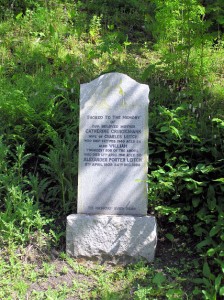
Alec and Ruby wanted to move to Cardonald where her parents lived and from where Ruby had been married. As housing was very tight, they finally managed it by moving in with Ruby’s parents. Meanwhile, Alec continued to work at Harland and Wolfe as Foreman and then Head Forman. Mr. Dunlop, the General Manager, took a keen interest in Alec and encouraged him to use his drafting skills.
A sister for Dorothy, Arlene Jean (now Patterson), was born in Orchard Park Nursing Home, Giffnock, in 1952.
When the Scottish shipbuilding industry reduced after the war, Alec began to earn his living by the use of his pencil. He worked closely with architects and draftsmen to set out building plans. He worked for several companies, two in particular, Giffin and Sons, Glasgow, and Serventi of London. He took great pride in his work and later on in life when Dorothy, his eldest child, returned to Scotland on visits from America, he would take her to the various buildings in which he could display the results of his work.
Alec worked hard all of his life and he was probably closest to his younger brother Willie who was killed during the war. He also had friends in Ruby’s two brothers, Thomas and Johnny. When other men might have retired to play golf or work in the garden, Alec continued to find employment. He used to boast that retirement was easy, “I’ve done it several times.”
Alec died in the Southern General Hospital having fallen from his bed in his Cardonald home on Christmas Eve. While Dorothy was told by the doctor at the hospital that he was only bruised, it is her belief that Alec thought he would not be allowed to return to his home in Cardonald, and simply closed up and died.
He is buried in the Glasgow Necropolis beside his mother, Catherine and younger brother, William.
Corlinda Lee
Friday, March 11th, 2011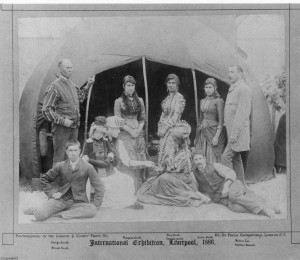 Corlinda Lee or Kurlinda as she was baptised on 2 October 1831 in South Wooton near King’s Lynn, Norfolk, was the daughter of Charles Lee and Union Chilcott. The Lee’s were a very prominent Epping Gypsy family.
Corlinda Lee or Kurlinda as she was baptised on 2 October 1831 in South Wooton near King’s Lynn, Norfolk, was the daughter of Charles Lee and Union Chilcott. The Lee’s were a very prominent Epping Gypsy family.
In 1856 Corlinda married George Smith, a horse trainer, (or Lazzy Smith as he was sometimes known), who was born in Norfolk in 3rd May 1830 and was a member of the East Anglian Smith family. Like the Lees, the Smiths were also a very important Gypsy family, and when Corlinda and George married it was the merging of two dynasties.
George took the surname of Smith from his mother, Elizabeth. His father was Elijah Buckley, who legend has it, was killed in a brawl in a public house at High Beech, Epping Forrest, when George was very young. From then onwards they never used the surname Buckley.
Shortly after their marriage George became the head of ten Gypsy families, (the clan chief, so to speak), and George and Corlinda become King and Queen of the Gypsies and had a family of eight children, 4 sons & 4 daughters (Charles, Frederick, Ernest, Patrick, Midora, Alice, Margaret, and Cecilia).
George was a bit of a character, but a smart money man. Victorians were intrigued by all that was different to their lives, anything that was mysterious appealed. So George took his family on tour all over Great Britain, and held “Gypsy Balls”, where the public could come and see how they lived and dressed, what their gypsy caravans were like inside and the ladies could have their fortunes read. All for the price of a small admission fee!!
Now this is where something very important happened to the lives of the Smiths. Whilst holding one of their Royal Epping Forrest Gypsy balls at Knockenhair Park in Dunbar on August 1878, Queen Victoria and entourage visit, and Victoria had her fortune read by Corlinda Lee. After that all well positioned ladies wanted an appointment, if it was good enough for the Queen it was good enough for them!!
Corlinda Lee died on 28th March 1900 aged 68 years at 42 New City Road in Glasgow, and her gravestone reads:
Her love for her children was great and she was charitable to the poor.
Wherever she pitched her tent she was loved and respected by all.
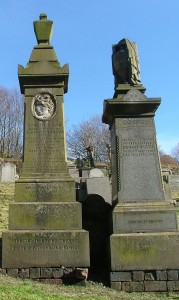
Her son Ernest is buried beside her in the Glasgow Necropolis, along with her grandchild May who only lived for fourteen months.
George was a bit of a character, but a smart money man. Victorians were intrigued by all that was different to their lives, anything that was mysterious appealed. So George took his family on tour all over Great Britain, and held “Gypsy Balls”, where the public could come and see how they lived and dressed, what their gypsy caravans were like inside and the ladies could have their fortunes read. All for the price of a small admission fee!! George Smith died in Swansea many years later.
Photo credit: Corlinda Lee & George Smith : By courtesy of the University of Liverpool
Corlinda is the person sitting in the middle reading a palm and George is the top left person.
The Laidlaw Family
Friday, March 11th, 2011This profile was supplied by Mr Martyn Webster*
The Laidlaw family of Edinburgh and Glasgow is one which I have researched fairly extensively. I am not a family member but I think you will find the following of interest and hopefully of use for your researchers. Martyn Webster, Brighton
The Laidlaws began in the early nineteenth century as brass founders and venetian blind makers at Simon Square Edinburgh. Later they set up as iron founders at Milton Street Glasgow and they lived at fashionable addresses in that city.
Their main claim to fame was that they manufactured all of the ornate ironwork used in the construction of many of the early Victorian pleasure piers around our coasts and the few surviving structures are at Hastings, Brighton West Pier and Blackpool North.
They worked with the prestigious pier designer Eugenius Birch, a man much exalted in his contemporary circles. Other products from their foundry found their way around the world to parks and gardens as far away as Melbourne, Australia and central America. Laidlaw remained an on going family firm of iron founders right up until 2006 when their last business at Livingstone passed into American ownership.
Descendants of what is an extremely large family still live in Edinburgh.
Through the help of,Miss Goldie,at the Largs Museum, a bust of David Laidlaw senior was traced to the McLean Museum and Art Gallery, Greenock. The Laidlaws lived in a very large mansion called Beechwood at Wemyss Bay which has been recently demolished.
*The researcher, Martyn Webster, belongs to the National Piers Society and has been recording the history of the Laidlaw/Birch pier at Deal in Kent from its completion in 1864 until its destruction by acts of war in 1940.This pier was a supreme example of its kind and was built on iron piles which actually screwed into the seabed according to a Eugenius Birch patent. The Laidlaw family actually owned, managed and ran Deal Pier between 1864 until 1920 when it was bought from them at a cost of £12,000 by Deal Borough Council.
Deal Pier
The extensive file on the Laidlaw ownership of this pier is deposited at the Scottish National Archives in Edinburgh as it was a Scottish registered company, the Deal and Walmer Pier Company. A most unusual and extraordinary state of affairs by any standards – a pier on the English south coast built, owned and run by a Scottish registered company whose managing directors were all members of the same family.
The dossier of papers on this subject will be donated by Mr Martyn Webster to a suitable institution in Scotland.









